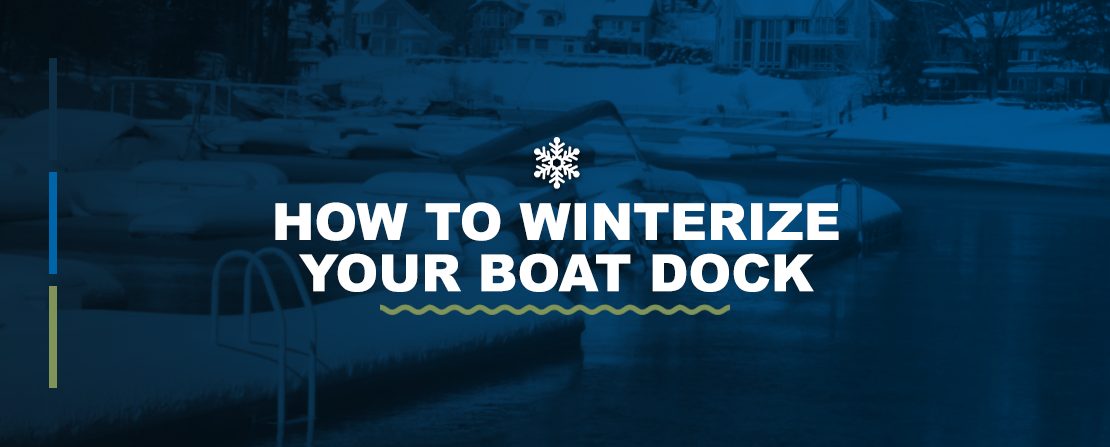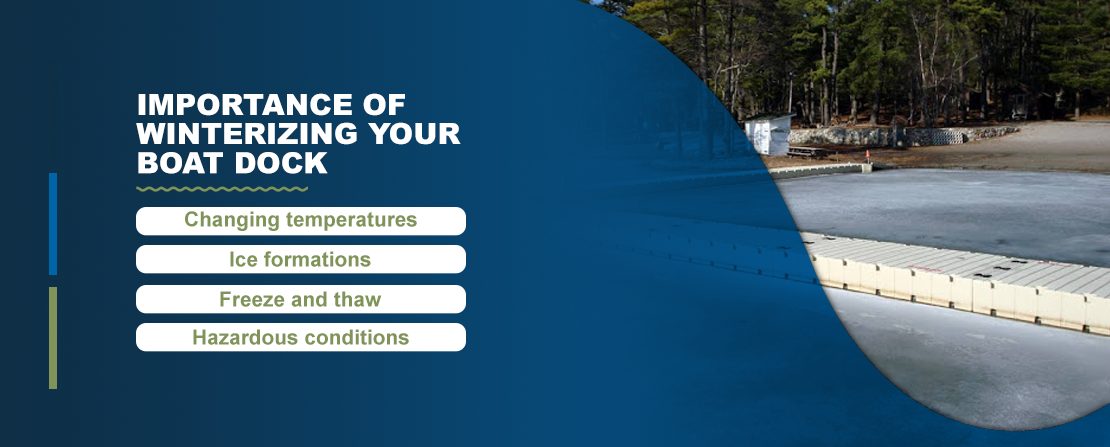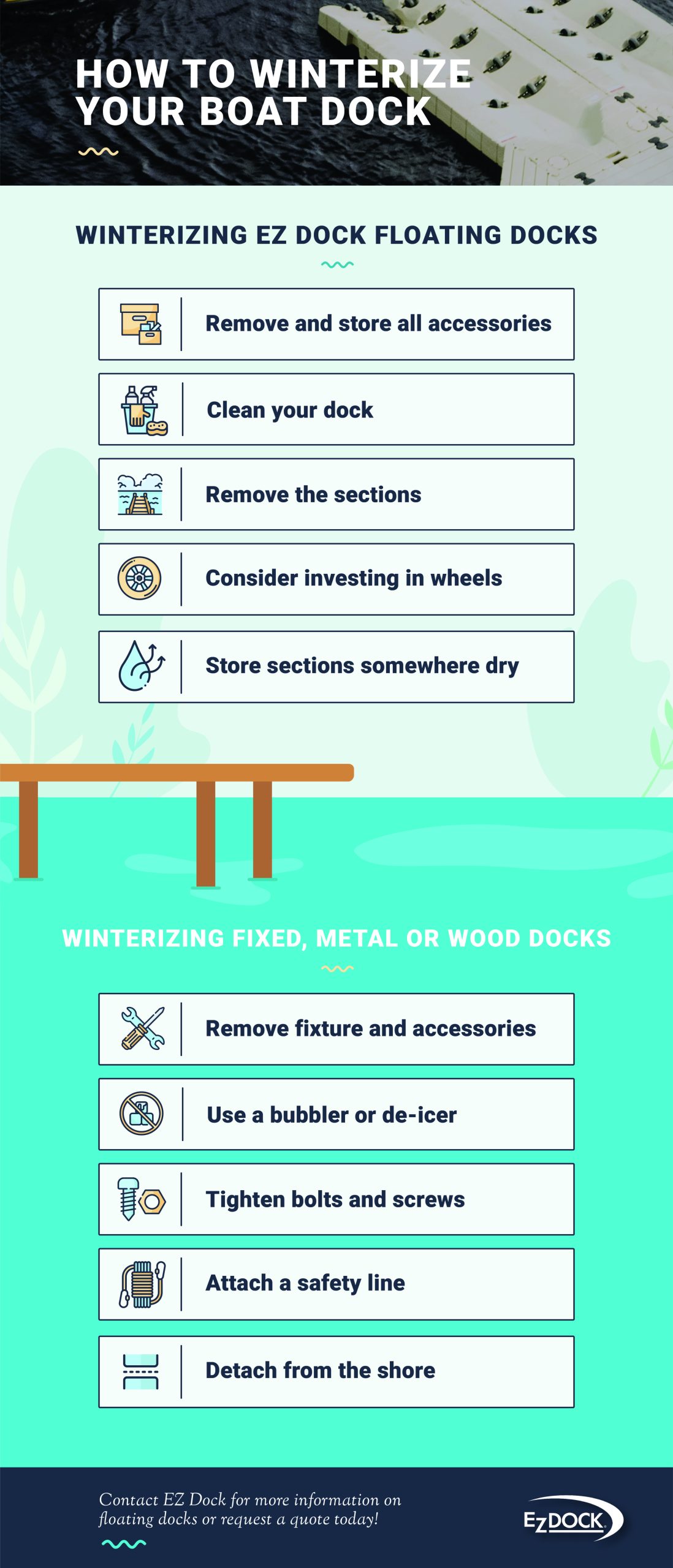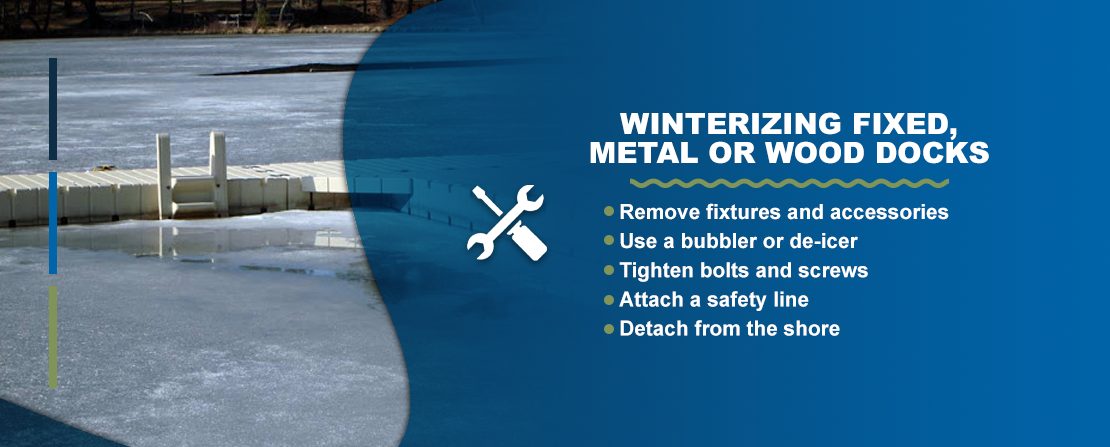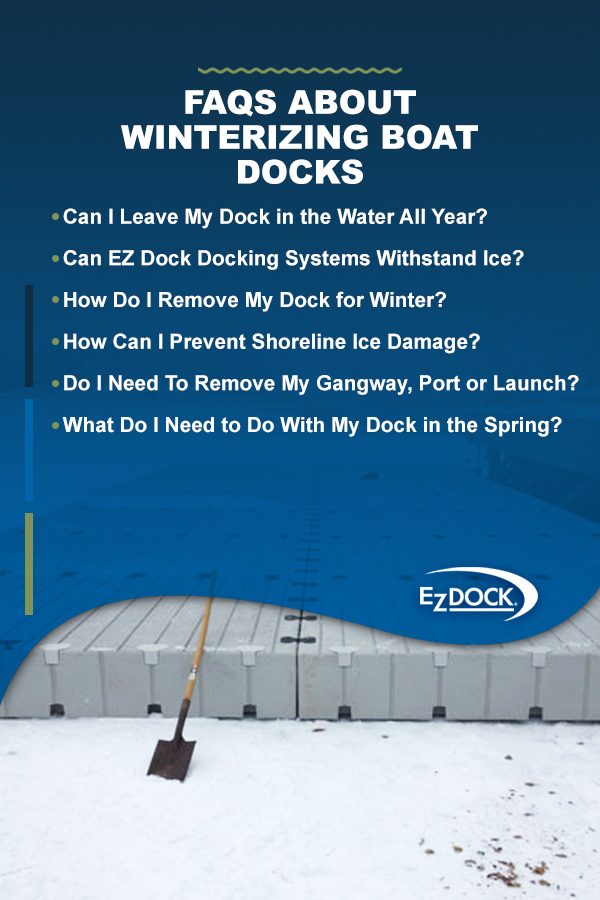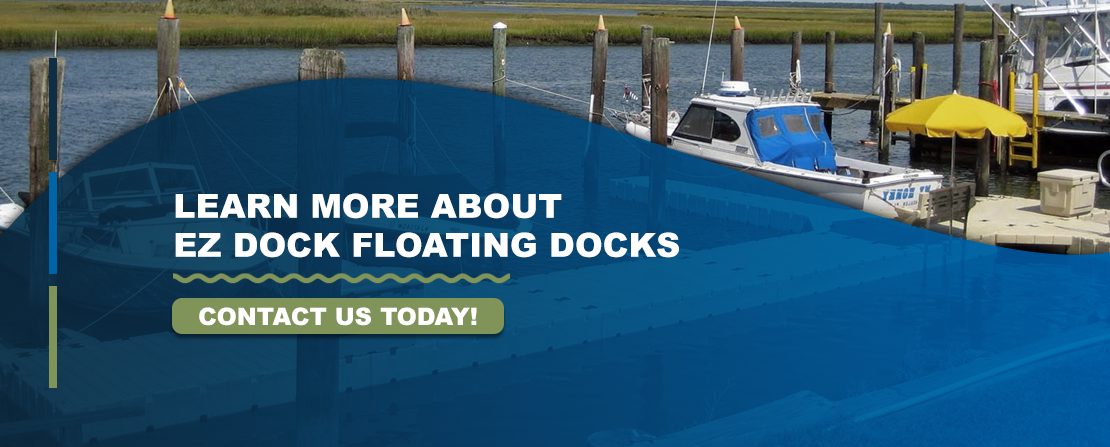Filters
How to Winterize Your Boat Dock
As summer fades into fall, property owners are busy making winter preparations around their homes, businesses, landscapes and docks. Snow, ice and fluctuating extreme temperatures in the winter threaten your dock and shoreline. Winterizing boat docks is an essential part of dock and waterfront property ownership because it preserves your structures and minimizes environmental damage.
Read on to learn more about floating dock winter preparation, including some helpful tips for a successful season.
Read the full article or jump to a specific section:
- Importance of Winterizing Your Boat Dock
- How to Winterize Your Boat Dock
- Tips for Preparing Your Boat Dock for Winter
- FAQs About Winterizing Boat Docks
- Learn More About EZ Dock Floating Docks
Importance of Winterizing Your Boat Dock
Winterizing your boat dock is an essential part of preserving its structural integrity and promoting longevity. Winter brings along several risks to your dock and property, including:
- Changing temperatures: As temperatures fluctuate in the winter, some dock materials — like wood — may contract and expand. This constant movement can warp wooden dock boards. Other types of dock materials, like polyethylene, are safe from expansion and shrinkage.
- Ice formations: Ice can be very detrimental to anything in its path. If it forms on your dock, the pressure can cause costly damage. Floating ice formations on the water can also crash into your dock or gangway via strong currents, leaving behind scratches, scuffs or structural damage.
- Freeze and thaw: As water enters a cycle of thawing and freezing, water levels may rise and fall. Should water levels get too low, floating docks may scratch against the floor of your lake or pond. Should they get too high, fixed docks may become inaccessible and frozen over. The constant freezing and thawing may also loosen the fasteners in some types of docks.
- Hazardous conditions: Docks get slippery in the winter, and most bodies of water reach dangerously cold temperatures. Storing and winterizing your dock is the most effective way to discourage anyone from attempting to access or use it during unsafe weather conditions.
By eliminating exposure to these risks, you save yourself a lot of money, time and frustration. When you take the time to winterize your dock, it will be far easier to reassemble it in the spring, meaning you’re that much closer to getting back on the water.
How to Winterize Your Boat Dock
The best method for winterizing your boat dock depends on what type of dock you own. EZ Dock floating docks are made of durable, winter-resistant polyethylene, so you don’t need to do as much work to prepare them for the season. They’re also easy to relocate. Permanent docks and docks made of wood or metal are more complicated.
Winterizing EZ Dock Floating Docks
One of the biggest advantages of owning an EZ Dock floating dock is how simple it is to winterize. Thanks to their durable polyethylene construction and thick, air-filled flotation chambers, you don’t have to worry about applying any special treatments or replacing metal fasteners.
To winterize your EZ Dock, follow these steps:
- Remove and store all accessories: Before you remove your floating dock, you first need to detach and store all accessories, including everything from launches, storage containers and tie-up cleats to slides, benches and handrails.
- Clean your dock: Wipe down your dock sections and accessories as you store them away, so clean-up is easier in the spring. Either hand dry each section or allow it time to air dry before storing away for the season.
- Remove the sections: Our flexible, rubber couplers are easy to uninstall. Carefully remove the coupler bolt from each unit, one at a time, similar to how you installed it. Be sure to keep the dock sections level and steady, and do not lose any of the bottom coupler pieces. As you remove and store each section, consider adding a removable label to each one, indicating the correct order for reassembly. For some configurations, particularly at commercial facilities or marinas with extended docking systems, this is the best way to ensure correct installation in the spring.
- Consider investing in wheels: EZ Dock dock wheels are made from the same polyethylene construction as your dock, making them equally durable and damage-resistant. Attach them to your dock sections for quick, stress-free transportation to and from your storage facility.
- Store sections somewhere dry: Store your dock sections and accessories in a dry, secure area, preferably somewhere not too far from the shore for easy transportation. While there is no need to cover your EZ Dock sections, adding a tarp or choosing an enclosed storage space will minimize any dust or dirt that could collect on the outside.
Winterizing Fixed, Metal or Wood Docks
If you own a permanent, immovable dock — especially metal and wood structures — there are some steps you can take to protect it against excessive winter wear and tear:
- Remove fixtures and accessories: Even if you can’t remove your dock, store away as many fixtures and accessories as possible, including ladders, storage containers, furniture, removable railings, ramps and lights.
- Use a bubbler or de-icer: Bubblers and de-icers — also known as aerators — are a good way to minimize ice formations on your dock. They aerate the water, creating movement, which can help reduce ice. When using an aerator, use lights and signage to indicate to other boaters where it’s located in your pond or lake.
- Tighten bolts and screws: Tighten all bolts and screws and visually inspect for any loose nails before winterizing your dock. Fluctuating temperatures may encourage already-loose fasteners to slip out of place. Replace any worn or damaged fasteners.
- Attach a safety line: Tie a chafe-resistant rope from your dock to a fixed point nearby, like a tree or permanent structure. This will secure your dock, should it come loose during the winter or as ice thaws. Remember to tie the rope high enough to account for any tides or rising water levels.
- Detach from the shore: To minimize ice-related dock and shoreline damage, try to remove as much of your dock — including any ramps, stairs or gangways — from the shore as you can. Even if you cannot completely displace your docking system, reduce contact with the shoreline by installing riprap or working with a landscaper to protect your shoreline from erosion.
Tips for Preparing Your Boat Dock for Winter
Now that you understand the process of winterizing your boat dock and why it’s so important, here are some tips to help you work through the process.
Create a Winterization Plan
Start creating your winter plans in the spring or summer, so you can gather everything you need and know exactly where to begin once the weather starts to get cold. If you own a removable dock, choose a dry, secure area to store your dock and accessories. Decide how you’re going to move your floating dock sections from the shoreline to your storage facility, and consider asking a friend if they are willing to lend a hand when the day arrives.
Remember to allocate a few days to the winterization process. While disassembling and relocating an EZ Dock is simple, permanent docks or challenging landscapes might be trickier to navigate. By giving yourself a few days to complete the process, you’ll have enough time to clean your dock and make any necessary repairs. If you share your dock with any other boat owners, give them plenty of notice for your winterization plans, so they can remove their vessels and assist if necessary.
Inspect Your Dock Before and After Winter
Perform a thorough visual inspection of your dock, gangway and accessories before winterizing. Take photos of its current condition, especially if you plan to leave it in the water all season long. Note and repair any existing damages or vulnerable areas. Once the season is over, perform a second inspection after reinstalling your dock. Note any new changes, damages or markings. If you own a wooden or metal dock, check that all bolts, nails and screws are secure and free of corrosion.
Consult Your Owners Manual
If your dock came with an owners manual, check for specific winterization tips and tricks. The owners manual is a great place to find information about the easiest ways to disassemble, reassemble and inspect your dock before storing it.
Check Local Regulations
Always check with your marina, municipality or homeowners association regarding specific winter regulations for docks. Many places require complete dock removal by a specific date, while other locations may have assistants on hand to help you complete your project.
FAQs About Winterizing Boat Docks
With a little preparation, winterizing and storing your boat dock for the winter is simple. The more you understand about the process, the easier it will be to reinstate your docking system in the spring — and the sooner you can get back on the water doing what you love.
Here are some frequently asked questions about winterizing boat docks.
Can I Leave My Dock in the Water All Year?
It depends on the type of winter weather you typically experience. Most northern dock owners need to store their dock away for the winter, or whenever ice and snow begin to form. For some places, this could start as early as mid-autumn. If you experience harsh winters, you should remove your dock for the season and reinstall it when the risk for freezing temperatures is gone.
If you live in a warmer climate with mild or warm winters, it’s probably safe to keep your dock up all year — just keep an eye on the forecast.
Can EZ Dock Docking Systems Withstand Ice?
Because EZ Dock floating docks move with the water, they are usually safe from ice-related pressure. However, as ice moves toward the shore, it can move your dock and promote shoreline erosion. The safest course of action for your landscape and your docking system is to remove your dock and store it for the season. You should also remove any pipes and pilings, which may bend or warp when frozen.
Have more questions about your EZ Dock? Contact a representative today!
How Do I Remove My Dock for Winter?
EZ Dock couplers make it easy to disconnect and reattach your individual sections, especially when using a coupler installation tool. Consult your owners manual for specific instructions.
When storing your dock, do not drag it over rough or rocky terrain. While outdoor storage will not harm your EZ Dock, storing it in a secure place is the best way to keep it safe. Always store your individual sections with the walking surface facing upwards, or stacked along its edge.
How Can I Prevent Shoreline Ice Damage?
As currents move, freeze and thaw, they can cause extensive shoreline damage. “Ice heaving” and “ice jacking” are natural forces that create ice ridges along shorelines, creating a pushing motion that can destroy docks and cause erosion. While much of this is unavoidable, it makes removing your dock all the more necessary.
To minimize shoreline damage, you can:
- Remove your dock, gangway and ramp as soon as winter arrives.
- Work with a landscaping architect to develop an anti-erosion plan for your property.
- Install a seawall or lay stone riprap along your shoreline to help shield vulnerable areas.
- Incorporate soil-stabilizing trees, shrubs and plants into your shoreline landscaping.
Do I Need To Remove My Gangway, Port or Launch?
If possible, yes. Remove as many items from the water and shoreline as you can before winter to reduce any shore or dock damage. EZ Dock gangways, launches and ports are easy to remove and store alongside your dock in a dry, covered location.
What Do I Need to Do With My Dock in the Spring?
When the ice and snow begin to thaw, it’s tempting to rush out and get your dock back on the water. Just be sure that winter is truly over, and there are no more winter storms or extreme temperatures on the horizon. Otherwise, you could go through the work of reassembling your dock only for it to sustain ice-related damage.
When it’s time to reinstall, follow the same plan you used to winterize it — choose a day and recruit some help. Try to work on your dock when the water level is even, and not too high or low. Once you’ve successfully assembled everything, perform your post-winter inspections, make any necessary repairs and take new photographs. Give your dock a good spring cleaning, so it’s as good as new for the upcoming spring and summer seasons.
Learn More About EZ Dock Floating Docks
Whether you are building a new dock or considering an upgrade to an existing dock, EZ Dock floating docks are the ideal balance of style, convenience and quality — and what better time to plan for a new dock than over the winter season? You can easily integrate our modular docks into your existing setup or create your own unique layout. All of our docks are compatible with other EZ Dock products, including our EZ BoatPort, EZ Launch® Residential, EZ Launch Accessible Transfer System and all EZ Port systems.
Find an EZ Dock distributor near you to get started, or request your quote today!

